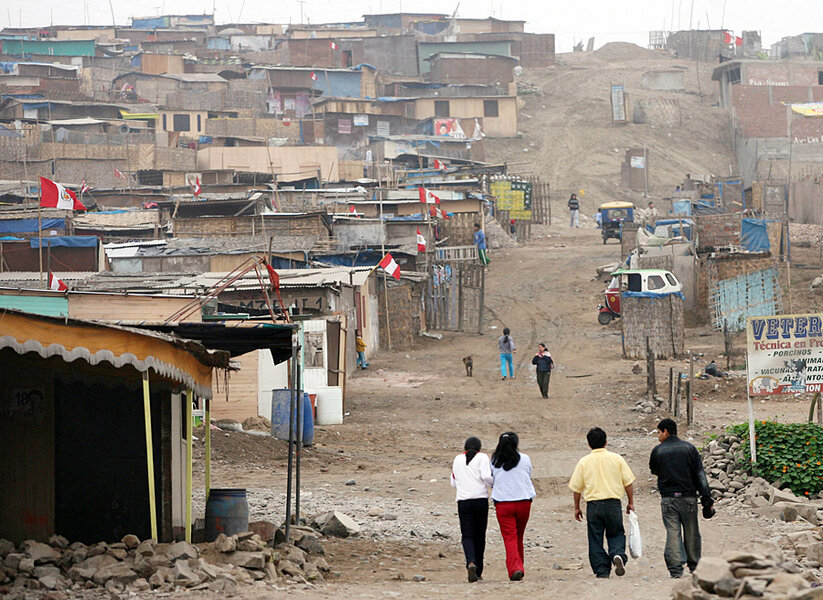What's a walk in the park worth in Peru?
Loading...
| Lima, Peru
In the Lima neighborhood of Villa Salvador, sand spills into the streets, and most of the concrete and brick houses have only the front façade painted, if anything at all. Most of its residents migrated here over the last thirty years – many fleeing rural violence during Peru’s civil war.
Despite shabby outward appearances, Villa Salvador has come a long way, says Mercedes Masa, who moved here almost twenty years ago. Take the local public park, for example, and its entrance fee for anyone over 12 years old – about $0.50 on weekdays, and $1 on weekends.
“This park wasn’t like this before,” Ms. Masa says. "Now there’s even a pool and a theater in here. Before it was just filled with sand."
The park, and its entrance fee, are part of a growing trend in Lima to expand access to public green space beyond upscale neighborhoods, to poorer districts. With cash-strapped local governments unable to afford the maintenance, many public parks in poorer neighborhoods now charge entrance fees, plus extra fees for services like picnic areas and swimming pools.
A growing movement of urban planners and young professionals is trying to make Lima more livable, in part by better integrating green space into people’s daily lives. Architect and urban planner Manuel de Rivero is part of that movement, and he’s careful to point out that the challenge isn’t simply social, but environmental, too: the city sits in the middle of a desert landscape, and receives virtually no rain.
“In Lima, green is never by default,” Mr. de Rivero says. “If you have an empty space in any other place, where it rains, it’s green. Here, it’s gray.
“This is a place where, naturally, you find hardly any tree, or any vegetated area,” he says.
That is a big issue for a city of 9 million, de Rivero says. Some European cities - like Madrid, for example - have upwards of 10 square meters of green space per person; Lima has less than 2.
It would be better for all parks in Lima to be free, says Anna Zucchetti, the head of the city’s Parks Commission. For now, however, she says it’s more important to simply make green space available – even if it involves charging fees for public parks.
“Lima is very fragmented into neighborhoods of different economic levels. To have public spaces at the city-wide level, where people of different backgrounds can come together, it’s also crucial for tolerance and diversity,” Ms. Zucchetti says.
Many residents of poor neighborhoods, like Masa, don’t seem to mind paying entrance fees for parks, despite the country’s historic divide between rich and poor and its legacy of entrenched inequality.
"In this country, there's simply an enormous gap between those that run things and have economic power, and everyone else," says psychologist and social commentator, Julio Hevia.
De Rivero believes it's about more than just inequality. Years of civil war and economic instability snuffed out the notion of citizens having certain rights, or a sense of a “public good” like public parks. While entrance fees might be scoffed at in other countries, in Peru they reflect a nascent sense of having a right to green space, or rights in general, he says. Some people even see paying for a park as a sign of status, de Rivero says.
'A better place to live'
Lima has a long list of urban challenges, particularly since its population has nearly doubled since the 1980s. De Rivero is largely positive about the changes, saying when compared to the past – particularly the civil war – today’s urban planning challenges don’t seem so daunting.
“There used to be this feeling that there is no future here. You had your parents telling you ... that maybe in a certain moment you’d have to flee somewhere,” he says.
As long as fees stay relatively low, many people do seem willing to pay. Masa comes to Huascar Park in Villa Salvador a few times a month with her 7-year-old daughter. During the week she works on the street, peddling children’s books, but says she doesn’t mind spending some of that money to go to the park. After all, the fee is less than she'd pay for a bus ride to take her daughter to a free park in another district.
On a busy Sunday afternoon Masa sits on the grass in the shade of a fragrant eucalyptus tree, while a few yards away, her daughter laughs and climbs around a jungle gym. It's a sharp contrast to the sandy front stoops just across the street.
“It’s not good that some people pay for their parks, and others don’t,” Masa says. “But I’m happy that there are people working to make Villa Salvador a better place to live.”







